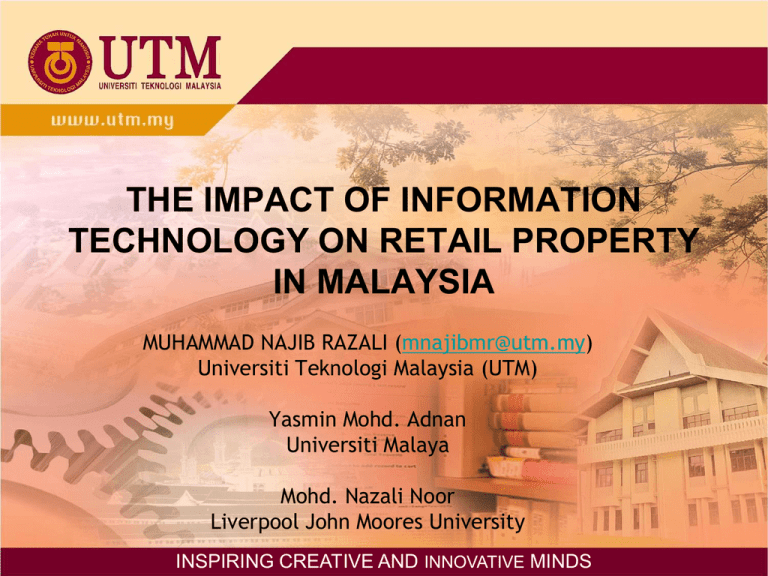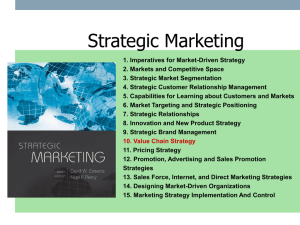file
advertisement

THE IMPACT OF INFORMATION TECHNOLOGY ON RETAIL PROPERTY IN MALAYSIA MUHAMMAD NAJIB RAZALI (mnajibmr@utm.my) Universiti Teknologi Malaysia (UTM) Yasmin Mohd. Adnan Universiti Malaya Mohd. Nazali Noor Liverpool John Moores University INSPIRING CREATIVE AND INNOVATIVE MINDS Introduction • Information technology is becoming a major form of communication, marketing and information dispersion tool in a business. • Gives wide coverage to reach potential client, better and quick information gathering and probably the cheapest way to sell the products. • E- commerce is one of the tools in information technology and it is believe it able improve the retail sales INSPIRING CREATIVE AND INNOVATIVE MINDS • • • • While some analyst predict a negative impact on retail sales due to the Internet, others argue that the Internet has no real future and that physical space will continue to attract shoppers (Worzala et al. 2002). E-services not only overcome previously conceived limitations of service marketing, it creates hitherto of opportunities for the marketers (Rahman, 2004). Internet simply a reallocation from other consumer spending or a siphoning off of some of the disposable income that would be going to mall (Kim, 2002) But essentially deterministic terms, the argument went, if ICT pervaded, productivity would increase and space requirements would reduce, thereby reducing the demand for real estate (Dixon and Marston, 2005) INSPIRING CREATIVE AND INNOVATIVE MINDS • • • • Over the period of 2007 to 2009, the total commercial property transaction value in Malaysia recorded a positive growth despite the global financial crisis (JLL, 2010). Malaysia came in second place in term of retail property transaction worth of US$1 billion (RCA,2010). Retail market in Malaysia also showed an average performance in 2009 although hit by global financial crisis in 2007/2008 (RCA, 2010). Rapid growth of economy in Malaysia has also resulted in higher internet penetration. Malaysia listed as one of the top 10 highest internet penetration in Asia and ranked at no. 57 in term of global internet penetration (Internet World Statistic) INSPIRING CREATIVE AND INNOVATIVE MINDS • • • • • • • Dixon (2005) and Dixon and Marston (2005) discussed on the impact of information technology on real estate in the new economics specifically using e-commerce among shopping centres in the UK. Kim (2002) surveyed in the US market. Worzala et al. (2002) explore on E-commerce on retail property in the UK and US. Dennis et al. (2007) discussed on the major issue in the economic and social effect of e-commerce on consumers on e-retailing and e-shopping. Some authors discussed on online shopping such as Bigne-Alcaniz et al. (2008) and Hand et al. (2009). The impact of information technology in retail property in certain countries such as South Africa (McClatchey et al., 2007), UK (Hand et al., 2007) and Spain (Alcanz et al., 2007). Littlefield (2000) focusing on internet real estate information on home purchasing. Methodology • The survey was conduct from January 2010 to December 2010 to obtain information concerning the implementation of IT among retailers in Malaysia and the impact on retail space specifically in major urban areas in Malaysia. • This survey examined the perceptions from retailers of wide key range of key IT applications issues. • Retailers were also asked about their opinion about the requirement space in term of future retail business in Malaysia. • 233 major retailers throughout major urban areas in Malaysia participate in this study (28% of sample respondents). INSPIRING CREATIVE AND INNOVATIVE MINDS Respondents’ profile Results and Discussion Business activities Households Apparel/ accessories Lifestyle Multi-product Food and beverage Others Company category Individual Corporation Proprietorship Franchise Partnership Joint venture Others Size of workers 5 or less 6-10 11-20 21-30 31-40 41-50 More than 50 Number % of total respondent 45 34 54 46 54 19.3 14.6 23.2 19.7 23.2 63 32 38 40 29 11 20 27.0 13.7 16.3 17.2 12.4 4.7 8.6 26 42 65 63 12 14 11 11.2 18.0 27.9 27.0 5.2 6.0 4.7 INSPIRING CREATIVE AND INNOVATIVE MINDS IT Implementation in Business 10% 5% 5% 0%-10% 19% 11%-20% 21%-30% 31%-40% 34% 41%-50% 27% INSPIRING CREATIVE AND INNOVATIVE MINDS More than 50% Applications 1. Hardware a. Desktop computer b. Tablet PC c. Office appliances (e.g. scanners, fax machine, laser printers) d. Video camera e. LCD TV f. Broadcasting system 2. Telecommunication a. Local Area Network (LAN) b. Virtual Private Network (VPN) c. Very Small Aperture Network (VSAT) d. Intranet e. Internet 3. Office productivity software a. Microsoft office b. Document readers c. Web browser d. Statistical package e. Graphic editors f. Special inventory software 4. Electronic applications a. Inventory stock control (e.g. RFID, Barcode system). b. Enterprise resource planning c. Clock-in system d. E-mail system e. Other applications f. Electronic catalogue g. Business transactions % responding “Yes” IT application among retailers in INSPIRING CREATIVE AND INNOVATIVE MINDS 100 62 Malaysia 100 32 67 23 5 0 0 53 100 100 100 100 72 75 53 82 12 100 100 54 72 75 Perception of retailers the growth of ICT application in retail business Apparel/Accessories Lifestyle Multi-product Food and beverage Others Overall Mean SD Mean SD Mean SD Mean SD Mean SD Mean SD 4.42 0.72 3.65 0.49 4.26 0.62 4.26 0.43 4.69 0.47 4.30 0.63 3.05 0.58 2.38 0.55 2.87 0.89 3.57 0.69 3.15 1.22 3.03 0.97 4.14 0.60 3.85 0.70 3.85 0.67 3.87 0.65 4.00 0.82 3.94 0.70 4.04 0.79 4.41 0.61 3.59 0.59 4.24 0.72 4.11 0.80 4.05 0.77 3.73 0.82 3.56 0.86 4.02 0.66 3.74 0.68 4.04 0.78 3.84 0.76 2.88 0.85 3.29 0.97 3.67 0.69 3.09 0.67 3.31 0.66 3.26 0.83 3.18 0.78 2.82 0.58 3.33 0.82 2.76 0.68 2.83 0.69 3.00 0.78 2.90 0.76 2.50 0.66 3.59 1.04 2.83 0.72 2.59 0.54 2.92 0.88 4.78 0.52 4.47 0.66 4.78 0.32 4.65 0.70 4.50 0.82 4.65 0.70 4.49 0.63 4.24 0.61 4.72 0.39 4.67 0.55 4.17 0.82 4.47 0.70 Security Maintenance Trust from customers Internet speed Knowledge Options Competition Law and regulation Customer fulfilment Image Overall 3.76 3.52 3.87 3.77 3.74 INSPIRING CREATIVE AND INNOVATIVE MINDS 3.75 Perceptions for the space requirements in 5 years Panel A Apparel/accessories Lifestyle Multi-product Food and beverage Others Overall Panel B Increase 21%-30% 31%-40% 0-10% 11%-20% (%) 8.9 (%) 4.4 (%) 13.3 (%) 17.8 11.8 38.9 26.1 25.9 22.3 5.9 22.2 28.3 22.2 16.6 23.5 11.1 34.8 11.1 18.8 4.3 0-10% 11%-20% 21%-30% Apparel/accessories Lifestyle Multi-product (%) 26.7 20.6 3.7 (%) 28.9 17.6 9.3 (%) 20.6 14.8 Food and beverage Others Overall 4.3 11.1 13.3 2.2 22.2 16.0 7.4 14.3 41%-50% (%) More than 50% (%) (%) (%) 11.1 13.7 24.1 23.4 19.8 18.4 11.1 Decrease 31%-40% Overall 41%-50% (%) INSPIRING CREATIVE AND INNOVATIVE MINDS More than 50% (%) Overall (%) 27.8 19.6 9.3 3.3 13.6 14.7 Perceptions of ICT on real estate space Panel A Apparel/accessories Lifestyle Multi-product Food and beverage Others Overall Panel B Increase 21%-30% 31%-40% 0-10% 11%-20% (%) 8.9 (%) 4.4 (%) 13.3 (%) 17.8 11.8 38.9 26.1 25.9 22.3 5.9 22.2 28.3 22.2 16.6 23.5 11.1 34.8 11.1 18.8 4.3 0-10% 11%-20% 21%-30% Apparel/accessories Lifestyle Multi-product (%) 26.7 20.6 3.7 (%) 28.9 17.6 9.3 (%) 20.6 14.8 Food and beverage Others Overall 4.3 11.1 13.3 2.2 22.2 16.0 7.4 14.3 41%-50% (%) More than 50% (%) (%) (%) 11.1 13.7 24.1 23.4 19.8 18.4 11.1 Decrease 31%-40% Overall 41%-50% (%) INSPIRING CREATIVE AND INNOVATIVE MINDS More than 50% (%) Overall (%) 27.8 19.6 9.3 3.3 13.6 14.7 Non-parametric tests of the response ICT related issue by different categories type of respondents Retailers characteristics SpaceICT OppICT PerfICT By business activities Reject Do not reject Do not reject By size of workers Reject Reject By company category Reject Do not reject Reject Reject INSPIRING CREATIVE AND INNOVATIVE MINDS • The null hypothesis on negative ICT use and real estate space relationship were rejected for all treatment effects of firms by business activities, size of workers and company categories. • There is evidence that companies’ perception that ICT use will not have a negative impact on real estate space needs differs across sample firms with different characteristics. • SpaceICT (ICT use will lead to reduction in office space) = dependent on business activities factor • OppICT (ICT could create new opportunities) = Differ only across companies occupying office of different sizes •PerfICT (ICT could improve business performance) = The null hypothesis was not rejected for business activities factor at 5 percent significance level. Conclusion This paper seeks to look into the impact of Information Technology (IT) among retailers in Malaysia in several major shopping complexes in Malaysia. The findings showed that majority of retailers in Malaysia using almost 40% of IT application in the business. T The most popular IT applications and equipment such as desktop, office appliances, Internet, Microsoft office, document readers and web browsers as well as clock-in system and e-mail system indicated 100% practice among respondents. Most of retailers’ also have high confidents the development of IT in retail business specifically in he measure of security, customer fulfilment, and for image purpose. The survey showed that although retail business will hit by online trading in future, however most of the retailers perceive the space will increase around 0%10% and only 14% of respondents believe the space will decrease about 21% to 30% in 5 years time. From this research although most of the retailers comfortable with the IT development and some of the also highly applied in their business, it is believe in future the space requirement to retail property will increase. This is due most of the customers are still needs physical shopping experience. In this new economy era and globalisation world IT play an important role in business and eventually to the growth of property. However in Malaysia the theory space requirement will decrease due to the growth of IT and borderless is not necessarily true. As retail property form a major growth in urban areas, as such it is important to study the impact of IT to retail business. The growth of retail property will accelerate the economic growth in urban areas which also contributes by the growth of population. Terima Kasih








